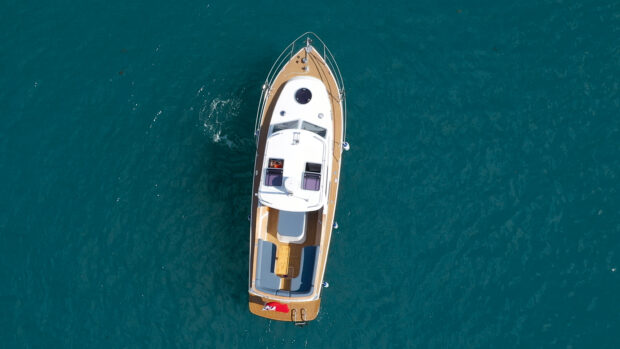In this series of Cruise Further, Cruise Safer articles and videos we plan to give you the skills and the confidence to push your cruising boundaries and make more of your boat's full potential. This article explains how to safely moor your boat stern-to.
Stern-to mooring is standard practice in most Mediterranean marinas because it allows them to cram more boats into a limited space without building rows of costly pontoons. But for British boat owners used to the space and luxury of coming alongside your own finger pontoon, it can come as quite a shock.
Sometimes the gap you’re being asked to squeeze into simply looks too small for the size of craft you’re helming, but follow our advice and with a bit of practice you’ll soon get the hang of it.
In its simplest form you drop your anchor a good distance out, reverse to the quay wall and attach your stern lines, then pull in on the anchor to position the boat correctly.
This works well when there’s plenty of space to manoeuvre but in a busy harbour untangling all the anchors when it’s time to leave can be a real pain. That’s why many marinas have now installed their own sea bed anchors with individual lines to attach to your bows. These ready-laid bow lines are led to the quay with a lighter line called a lazy line, which you collect while attaching your stern lines then lead forward to pull the bow tight.
Using your anchor
To secure a berth in a harbour which requires you to drop your anchor and reverse in, line up your boat stern to the quay and start reversing slowly. Drop the anchor when you are roughly four boat lengths away and keep the boat gently moving astern.
When you are about a boat length from the quay, snub the anchor to ensure it has dug in, then continue to let it out slowly while still reversing until you are close enough to attach the stern lines.
If there is a cross-wind, you will need to drop your anchor slightly upwind of your berth, so that it keeps the bow to windward while you reverse in. However, before you do anything, tell your crew the plan before you start. It’s hard to communicate instructions above the noise of the winch, and remind everyone, never ever try to free a chain jam with fingers.

Prepare two stern lines and put out fenders on both sides. These will need to be higher than when berthing on a pontoon so you can lean against neighbouring boats if the space is tight.
Using lazy lines
To moor in a harbour with lazy lines, you need to do some simple preparation work first.
Prepare stern lines and fenders on both sides and hang them much higher than you would with a pontoon system, as you may well be pushing between your neighbours to create the space that will be your berth.
If you have a passerelle extend it now to just above the height of the quay to give you the option of stepping ashore if there is no one there to take your lines.
Check which direction the wind is coming from (wind on the stern is easiest, while a cross-wind or wind on the bow is more difficult), and check your bow thruster is working.

Try to approach the berth stern-first (with any cross-wind on the stern) so that you are ready to reverse into it. Bring the boat level with the berth then spin it round before slowly backing into the space. If a cross-wind has narrowed the gap you may need to lean gently on the windward boat.
It’s usually easiest to approach your berth stern-first, ready to reverse into your spot. This may mean going beyond your berth and then backing into it, or turning around before you reach it and backing up the aisle towards it. If there is a cross-wind always try to approach it with the wind on your stern.
Bring the boat almost to a halt when you are level with your berth. Now spin the boat slowly to line it up, then reverse in at low speed. A strong cross-wind may push your neighbouring boat across your berth, closing up the gap you’re trying to squeeze into. If that’s the case, the best plan is to reverse up to the windward boat with a big fender positioned on the quarter, then lean very gently against the other boat to create the space needed.

A big fender on the stern quarter will help protect both boats as you manoeuvre into the gap. Once you are halfway into the space the boats on either side will help hold you in place as you back gently towards the quay. Make sure your crew are ready with the stern lines and the passerelle is correctly positioned for them to step ashore.
Once you have half of the boat in the space, the boats on either side will help hold everything steady and as the stern gets nearer to the dock, the crew can then either lasso the bollards, pass the stern lines to a helper, or step ashore from the passerelle. Always attach the windward line first, then the leeward line.
Once the stern lines are secure, collect the lazy line from the dock wall and take it forward, making sure you lead it outside the fenders and rails, using a boat hook if necessary. The line runs along the sea bed under the boat to a thicker line, which is anchored to the sea bed. It’s nicknamed the slime line for a reason, so wear gloves. Pull this up tight enough to keep the boat off the quay. Berths for larger boats may have two bow lines with corresponding port and starboard lazy lines to hold the bow in place. If that’s the case, lead each one through the appropriate fairlead and cleat off.
Once you are in your berth and the lines are on, it’s now time to tidy up. Adjust the bow tension and stern line lengths so that the boat is far enough from the quay to ensure it won’t touch in a strong headwind, but not so far that you can’t step aboard it.

Adjust the bow and stern lines to keep you away from the quay but close enough to step ashore when needed and add cross springs to hold your boat in place.
Lastly, wash off any mess from the anchor chain or slime lines which has dripped on to the foredeck or topsides as the mud sets like concrete when it dries.
Some simple tips that make stern-to berthing easier:
Once lined up, be nice and gentle on the power.
Bow and stern thrusters really help for positioning, but remember that the boat pivots around the centre, so small bursts of power are best.
If it looks like being a tight squeeze in or out consider tying the fenders on to stanchion bases rather than the grabrail to avoid any chance of the rail getting bent as the fenders roll between the boats.
The first line on should always be the windward line.
Always leave some slack on the stern lines until the bow line is attached.
Adding cross-springs to the stern will help keep your boat square to the quay.
If you have an offshore wind, keep the stern lines tighter.
Conversely, if the wind is onshore, keep the bow lines tighter.
Leave a little bit of slack in the lines to deal with any swell.
Next article: Berthing in windy conditions.
Subscribe to the print version of MBY
Subscribe to a digital version of MBY











